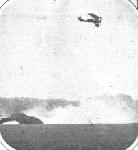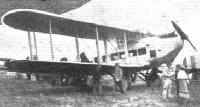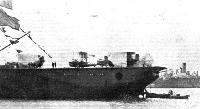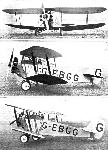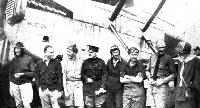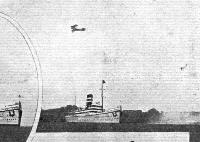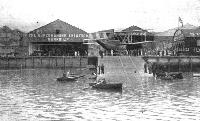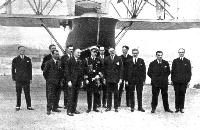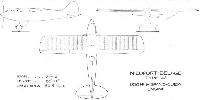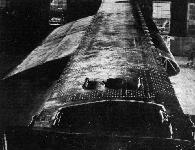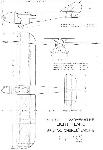Фотографии
-
EVENT AT THE R.A.F. PAGEANT: One of the five Sopwith "Snipes" bombing the disabled "tank."
Самолёты на фотографии: Sopwith Snipe / 7F.1 - Великобритания - 1918
-
Регистрационный номер: H-NACC THE LATEST FOKKER COMMERCIAL: The Fokker F.VII, fitted with Rolls-Royce "Eagle IX," is a development of the famous F.III, but has accommodation for two pilots and eight passengers. The machine has a communication door between the pilot's cockpit and the cabin, and is provided with wireless telephony installation. On its first test flights this machine carried a load equivalent to 16 passengers. The undercarriage is of unusual design, giving a very wide wheel track. The tension of the springing is provided with special adjustment for varying loads.
Самолёты на фотографии: Fokker F.VII / C-2 / F.XIV - Нидерланды - 1924
-
AT THE R.A.F. PAGEANT: One of the larger machines which took part in the "Fly Past": The Avro "Andover," an aerial ambulance (Rolls-Royce "Condor").
Самолёты на фотографии: Avro Andover / Type 561/563 - Великобритания - 1924
-
THE R.A.F. PAGEANT: The first event: Message picking-up competition. On the left is shown a machine diving towards the "goal posts" supporting the message on the cross-line. On the right a machine is shown swooping upwards after having successfully grappled the message by means of its trailing hook-line.
Самолёты на фотографии: Bristol F.2A/F.2B Fighter - Великобритания - 1916
-
A few of the Supermarine amphibians on board the Spanish Government vessel en route for Spain.
Самолёты на фотографии: Supermarine Sea Eagle - Великобритания - 1923
-
AT THE R.A.F. PAGEANT: One of the larger machines which took part in the "Fly Past": The Parnall "Possum" triplane (Napier "Lion"), with gear transmission
Самолёты на фотографии: Parnall Possum - Великобритания - 1923
-
ANOTHER ROUND-THE-WORLD FLIGHT? Major Pedro Zanni, of the Argentine Air Service, with his Fokker biplanes (450 h.p. Napier "Lion") who is attempting an aerial round-the-world dash, starting and finishing at Amsterdam. He will be accompanied by Lieut. Nelson Page and Chief Engineer Beltrame, both of the Argentine Air Service.
Самолёты на фотографии: Fokker C.IV / DC.I - Нидерланды - 1923
-
THE UDET "KOLIBRI" LIGHT MONOPLANE: Side view.
Самолёты на фотографии: Udet U-7 Kolibri - Германия - 1924
-
THE UDET "KOLIBRI" LIGHT 'PLANE: This German machine is fitted with a 500 c.c. Douglas engine. The three-quarter front view gives a good idea of the general design. A flight of more than two hours' duration has been made on the "Kolibri."
Самолёты на фотографии: Udet U-7 Kolibri - Германия - 1924
-
THE R.A.F. PAGEANT: THE Event of the Day. British aircraft appearing on the scene are fired at with the "Slevic's" anti-aircraft guns, which are silenced by a formation of Fairey "Flycatcher" fighters until (on photo) a formation of Blackburn "Dart" torpedo-carriers discharge their torpedoes.
Самолёты на фотографии: Blackburn Swift T.1 / Dart T.2 - Великобритания - 1920
-
AT THE R.A.F. PAGEANT: One of the larger machines which took part in the "Fly Past": The Handley Page "Hyderabad" and the Vickers "Virginia," twin-engined (Napier "Lions") bombers.
Самолёты на фотографии: Handley Page Hyderabad/H.P.24 / Hinaidi/H.P.33 / Clive/H.P.35 - Великобритания - 1923Vickers Virginia - Великобритания - 1922
-
A "Bristol" Tourer, recently supplied to Bulgaria, giving a demonstration of flying during a display by the N.N.A.K'S, a Bulgarian Gymnastic Society at Sofia. It may be noted, with a strong magnifier, that some of the gymnasts were unable to restrain their curiosity and remain "eyes front," as the Bristol passed over
Самолёты на фотографии: Bristol Tourer - Великобритания - 1919
-
Регистрационный номер: G-EBGG The Bristol "Bloodhound" is a two-seater fighter, built entirely of metal. Note the back-swept wings. The engine is a Bristol "Jupiter."
Самолёты на фотографии: Bristol Bloodhound / Type 84 - Великобритания - 1923
-
AT THE R.A.F. PAGEANT: Single-seater fighter - the Hawker "Woodcock" biplane (Bristol "Jupiter").
Самолёты на фотографии: Hawker Woodcock - Великобритания - 1923
-
ARRIVAL OF THE AMERICAN WORLD-FLYERS. The three Douglas World-Cruisers, with Lieut. Smith's "Boston" leading, arriving at Croydon
Самолёты на фотографии: Douglas DWC / World Cruiser - США - 1923
-
THE AMERICAN WORLD-FLYERS AT CROYDON: Two views of the three Douglas World-Cruisers, which are fitted with "Liberty" engines. They are named respectively "Boston," "Chicago," and "New Orleans."
Самолёты на фотографии: Douglas DWC / World Cruiser - США - 1923
-
THE AMERICAN WORLD-FLYERS AT CROYDON: Reading from left to right are Lieut. Lowell Smith (leading pilot), Lieut. L. P. Arnold of the "Boston," Serg. H. H. Ogden (Mechanic of the "New Orleans"), the American Military Attache K. A. Joyce, Lieut. J. Harding (Mechanic of the "Chicago"), Lieut. Leigh Wade (pilot of the "New Orleans") and Lieut. Erik Nelson (pilot of the "Chicago").
Самолёты на фотографии: Douglas DWC / World Cruiser - США - 1923
-
THE R.A.F. PAGEANT: THE Event of the Day. British aircraft appearing on the scene are fired at with the "Slevic's" anti-aircraft guns, which are (on photo) silenced by a formation of Fairey "Flycatcher" fighters until a formation of Blackburn "Dart" torpedo-carriers discharge their torpedoes.
Самолёты на фотографии: Fairey Flycatcher - Великобритания - 1922
-
Регистрационный номер: G-AUIM [2], G-EBIM [2] THE D.H.51 BIPLANE: Three-quarter front view.
Самолёты на фотографии: De Havilland D.H.51 - Великобритания - 1924
-
Регистрационный номер: G-AUIM [2], G-EBIM [2] THE D.H.51 BIPLANE: Side view.
Самолёты на фотографии: De Havilland D.H.51 - Великобритания - 1924
-
Side elevation of the D.H.51 showing arrangement of cockpits, seats, controls, &c.
Самолёты на фотографии: De Havilland D.H.51 - Великобритания - 1924
-
THE D.H.51: On the left a sketch showing hinged door and sliding cockpit fairing. On the right the rubber-closed slot for the rudder bar.
Самолёты на фотографии: De Havilland D.H.51 - Великобритания - 1924
-
D.H.51 90 HP. R.A.F.1A or 80 HP. Renault Engine
Самолёты на фотографии: De Havilland D.H.51 - Великобритания - 1924
-
Регистрационный номер: G-EBJY [2] THE PRINCE OF WALES VISITS SUPERMARINE AVIATION WORKS: A view of the works, slipway, etc., with a "Swan" amphibian being brought out.
Самолёты на фотографии: Supermarine Swan - Великобритания - 1924
-
Регистрационный номер: G-EBJY [2] THE PRINCE OF WALES VISITS SUPERMARINE AVIATION WORKS: In the group below, standing in front of the "Swan," are seen, left to right : Mr. C. Gray, Secretary of the Supermarine Aviation Co.; Mr. Cross, Accountant; Mr. Elliott, Works Manager; Commander Cowdy, Director; Mr. G. L. Wood, Chairman; H.R.H. the Prince of Wales; Mr. J. Dickenson, Director; Commander J. Bird, Managing Director; Capt. H. C. Biard, Chief Test Pilot; Mr. R. J. Mitchell, Chief Engineer and Designer; Capt. Leigh-Mossley, Director; and Mr. H. Victor Paine.
Самолёты на фотографии: Supermarine Swan - Великобритания - 1924
-
Three-quarter front view of the Nieuport-Delage type 42, with 600 h.p. Hispano-Suiza engine.
Самолёты на фотографии: Nieuport-Delage Ni-D-42 / Ni-D-62 - Франция - 1924
-
The 600 h.p. Hispano-Suiza engine fitted on the Nieuport-Delage 42
Самолёты на фотографии: Nieuport-Delage Ni-D-42 / Ni-D-62 - Франция - 1924
-
THE NIEUPORT-DELAGE TYPE 42: Longitudinal section through fuselage. A and B are the bulkhead formers to which wings and chassis struts are attached, while C is one of the longitudinal duralumin bearers.
Самолёты на фотографии: Nieuport-Delage Ni-D-42 / Ni-D-62 - Франция - 1924
-
Nieuport-Delage Type 42 600 HP. Hispano-Suiza Engine
Самолёты на фотографии: Nieuport-Delage Ni-D-42 / Ni-D-62 - Франция - 1924
-
THE CENTRAL SECTION OF A ROHRBACH WING: This wing, built entirely of duralumin, is in three sections, the leading and trailing edges being separate structures bolted to the main, load-carrying, structure.
Самолёты на фотографии: Rohrbach Ro.II - Ro.IV - Германия - 1923
-
THE ROHRBACH Ro.II: On the left a view showing the two engines, the nose of the boat, and one of the wing floats. The large wheels are used for transport on land only. On the right a close-up view of the windows, etc., of the pilot's cockpit.
Самолёты на фотографии: Rohrbach Ro.II - Ro.IV - Германия - 1923
-
View along the wing of the Rohrbach Ro.II. Note the number of rivets used in attaching the duralumin wing covering.
Самолёты на фотографии: Rohrbach Ro.II - Ro.IV - Германия - 1923
-
THE ROHRBACH RO.II ALL-METAL FLYING BOAT: Two Rolls-Royce "Eagle" Engines. The men standing on the wings give a good idea of the size of the machine.
Самолёты на фотографии: Rohrbach Ro.II - Ro.IV - Германия - 1923
-
AT THE R.A.F. PAGEANT: New two-seater fighter biplane which took part in the "Fly Past." The Vickers "Venture" (Napier "Lion").
Самолёты на фотографии: Vickers Vixen / Venture / Valparaiso / Valiant - Великобритания - 1923
-
AT THE R.A.F. PAGEANT: Single-seater fighter - the Bristol "Bullfinch" monoplane (Bristol "Jupiter")
Самолёты на фотографии: Bristol Bullfinch - Великобритания - 1923
-
Short Two-seater Light-plane Bristol "Cherub" Engine
Самолёты на фотографии: Short Satellite / S.4 - Великобритания - 1924
-
The Descamps-Brunet A.2 Sesquiplan: Three-quarter front view of a new French all-metal reconnaissance machine fitted with a 400 h .p. Lorraine-Dietrich engine.
Самолёты на фотографии: Descamps-Brunet DB-16 / DB-17 - Франция - 1924
-
The Descamps-Brunet A.2 Sesquiplan: Front view, showing the clean design and clear bomb space below the fuselage
Самолёты на фотографии: Descamps-Brunet DB-16 / DB-17 - Франция - 1924
-
Descamps-Brunet A2 Sesquiplan 400 HP. Lorraine-Dietrich Engine
Самолёты на фотографии: Descamps-Brunet DB-16 / DB-17 - Франция - 1924
-
Demonty-Poncelet Monoplane 40 hp Gregoire Engine
Самолёты на фотографии: SABCA DP (Demonty-Poncelet) - Бельгия - 1924
Статьи
- Flight
